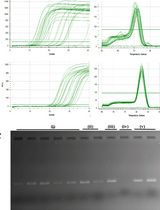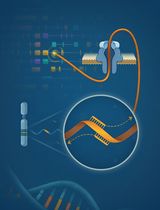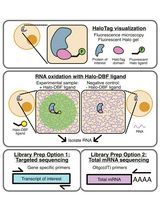- EN - English
- CN - 中文
Updated Pseudo-seq Protocol for Transcriptome-Wide Detection of Pseudouridines
新型Pseudo-seq方案用于转录组范围内假尿苷的检测
发布: 2024年05月05日第14卷第9期 DOI: 10.21769/BioProtoc.4985 浏览次数: 1544
评审: Anna SloutskinAnonymous reviewer(s)
Abstract
Pseudouridine (Ψ), the most prevalent modified base in cellular RNAs, has been mapped to numerous sites not only in rRNAs, tRNAs, and snRNAs but also mRNAs. Although there have been multiple techniques to identify Ψs, due to the recent development of sequencing technologies some reagents are not compatible with the current sequencer. Here, we show the updated Pseudo-seq, a technique enabling the genome-wide identification of pseudouridylation sites with single-nucleotide precision. We provide a comprehensive description of Pseudo-seq, covering protocols for RNA isolation from human cells, library preparation, and detailed data analysis procedures. The methodology presented is easily adaptable to any cell or tissue type with high-quality mRNA isolation. It can be used for discovering novel pseudouridylation sites, thus constituting a crucial initial step toward understanding the regulation and function of this modification.
Key features
• Identification of Ψ sites on mRNAs.
• Updated Pseudo-seq provides precise positional and quantitative information of Ψ.
• Uses a more efficient library preparation with the latest, currently available materials.
Keywords: Pseudo-seq (Pseudo-seq)Background
Many genetic diseases are caused by various mutations in specific disease genes. A significant proportion (~15%) of these mutations are nonsense mutations that create a premature termination codon (PTC) [1,2]. Consequently, the nonsense-mediated mRNA decay (NMD) surveillance pathway degrades a large fraction of PTC-containing mRNA [3]. Translation of the remaining undegraded PTC-containing mRNA terminates at the PTC, leading to no production of full-length protein and hence disease. Thus, suppressing NMD and translation termination at PTCs has become an attractive strategy for combating these diseases.
To address diseases caused by nonsense mutations in particular genes, substantial efforts have focused on altering PTC-containing mRNA associated with the condition. This alteration, occurring at the RNA and not DNA level, aims to convert the PTC back into a sense codon [4]. Inspired by this concept and considering the distinct chemical properties of pseudouridine (Ψ) compared to uridine, we have introduced a pioneering approach termed RNA-guided RNA pseudouridylation (U-to-Ψ conversion) [5,6]. This strategy targets the uridine within a PTC (UAA, UAG, or UGA), effectively inhibiting nonsense-mediated decay (NMD) while facilitating PTC read-through, leading to the production of a full-length functional protein in the cell. Our observations in yeast cells demonstrate a substantial increase in nonsense read-through upon converting the invariant U of a PTC into a Ψ [5,7].
The targeting of nonsense codons in yeast involves the expression of a designer box H/ACA guide RNA (gRNA), which possesses the capability to site-specifically direct the conversion of U to Ψ within the nonsense codon [8]. Box H/ACA gRNAs, abundant in archaea and eukaryotes, naturally direct pseudouridylation of rRNAs, snRNAs, and mRNAs in eukaryotes at specific sites [9–12]. Existing in the cell as a ribonucleoprotein complex (box H/ACA RNP), each box H/ACA gRNA directs site-specific pseudouridylation via distinctive base-pairing between the gRNA guide sequence and the substrate RNA [13].
Based on these observations, we have recently developed a novel approach, namely targeted PTC pseudouridylation, to suppress nonsense mutations in human cells [14]. By co-transfecting human cells with a designer box H/ACA gRNA gene targeting the PTC, we showed that targeted pseudouridylation suppressed both NMD and translation termination at PTCs. Targeted pseudouridylation appears to be the first RNA-directed gene-specific therapeutic approach that suppresses NMD and concurrently promotes PTC read-through.
To rule out the off-target effects of the gRNA transfection, we designed and performed Pseudo-seq to detect transcriptome-wide pseudouridylation. Recently, a number of Ψs have been predicted and experimentally detected by next-generation sequencing techniques [11,12,15,16]. In these techniques, RNA is first treated with carbodiimide N-cyclohexyl-N-(2-morpholinoethyl)carbodiimide metho-p-toluenesulfonate (CMC), which forms covalent adducts with the bases in guanidine, uridine, and Ψ [17]. Subsequently, alkaline hydrolysis removes the adducts from guanidine and uridine, but the CMC adduct at the N3 position of Ψ is resistant. The remaining CMC adduct on Ψ bases is an effective barrier to reverse transcriptase, which terminates one nucleotide before the modified Ψ. By mapping these strong reverse-transcription stop sites globally, the positions of Ψs can be determined. These methods are powerful and precise, but the original protocol has become obsolete due to a couple of factors. First, the adapters utilized in the initial Pseudo-seq are no longer compatible with current sequencers. Consequently, we substituted these adapters with a new set commonly employed in eCLIP [18]. Secondly, also based on eCLIP technical advances, adaptor ligation demonstrates higher efficiency than circularization [18]. Hence, we replaced the DNA circularization step with adapter ligation. With this revised Pseudo-seq technique, transcriptome-wide Ψs can be detected more efficiently in less-abundant mRNA.
Materials and reagents
Cells, reagents, and enzymes
HEK293T (ATCC, catalog number: CRL-11268)
DMEM (Gibco, catalog number: 11965)
FBS (Gibco, catalog number: 26140-079)
Trypsin (Gibco, catalog number: 25300054)
Opti-MEM (Gibco, catalog number: 31985070)
PEI MAX 40000 (Polysciences, catalog number: 49553-93-7)
TRIzol reagent (Invitrogen, catalog number: 15596018)
Glycogen (Thermo Scientific, catalog number: R0561)
Oligo d(T)25 magnetic beads (New England Biolabs, catalog number: S1419S)
T4 PNK (Thermo Scientific, catalog number: EK0031)
FastAP thermosensitive alkaline phosphatase (Thermo Scientific, catalog number: EF0651)
RQ1 RNase-free DNase (Promega, catalog number: M6101)
CMC [1-Cyclohexyl-3-(2-morpholinoethyl)carbodiimide Metho-p-toluenesulfonate] (TCI, catalog number: C0793)
T4 RNA ligase 1 (ssRNA ligase) (New England Biolabs, catalog number: M0437M)
SYBR Select Master Mix (Applied Biosystems, catalog number: 4472908)
ExoSAP-IT (Applied Biosystems, catalog number: 78200.200.UL)
AMPure XP Bead-Based Reagent (Beckman Coulter, catalog number: A63881)
SYBR gold nucleic acid gel stain (Invitrogen, catalog number: S11494)
Dynabeads MyOne Silane (Invitrogen, catalog number: 37002D)
RLT buffer (QIAGEN, catalog number: 79216)
2× Q5 PCR master mix (New England Biolabs, catalog number: M0492S)
NEBNext Multiplex Oligos for Illumina (Index Primers Set 1) (New England Biolabs, catalog number: E7335L)
3' RNA linker (RiL19): /5phos/rArGrArUrCrGrGrArArGrArGrCrGrUrCrGrUrG/3SpC3/ (Integrated DNA Technology, custom RNA oligo)
RT primer (AR17): dAdCdAdCdGdAdCdGdCdTdCdTdTdCdCdGdA (Integrated DNA Technology, custom DNA oligo)
3' DNA linker (rand3Tr3): /5phos/NNNNNNNNNNdAdGdAdTdCdGdGdAdAdGdAdGdCdAdCdAdCdGdTdCdTdG/3SpC3/ (Integrated DNA Technology, custom DNA oligo; see Note 1)
Chloroform (Thermo Scientific, catalog number: AC158210010)
Isopropyl alcohol (Thermo Scientific, catalog number: AC167880010)
RQ1 RNase-free DNase (Promega, catalog number: M6101)
Phenol:chloroform:isoamyl alcohol 25:24:1 (Thermo Scientific, catalog number: AAJ62336AN)
Sodium acetate (NaOAc) (Thermo Scientific, catalog number: AA1155430)
Sodium chloride (NaCl) (Thermo Scientific, catalog number: BP358-10)
Ethylenediaminetetraacetic acid, disodium salt dihydrate (EDTA) (Thermo Scientific, catalog number: S311-500)
Sodium dodecyl sulfate (SDS) (Thermo Scientific, catalog number: BP166-500)
Tris base (Thermo Scientific, catalog number: BP152-1)
Lithium chloride (Thermo Scientific, catalog number: L121-500)
Lithium dodecyl sulfate (Thermo Scientific, catalog number: AC413300250)
Potassium acetate (Thermo Scientific, catalog number: P171-500)
Magnesium acetate (Thermo Scientific, catalog number: AC212550010)
Acetic acid (Thermo Scientific, catalog number: A38-212)
MES (Thermo Scientific, catalog number: BP300-100)
Bicine (Thermo Scientific, catalog number: AC327711000)
Sodium hydroxide (Thermo Scientific, catalog number: AC327715000)
Sodium carbonate (Thermo Scientific, catalog number: S263-500)
Bromophenol blue (Thermo Scientific, catalog number: AAA1846909)
Xylene cyanol (Thermo Scientific, catalog number: C422690050)
Formamide (Thermo Scientific, catalog number: BP228-100)
Boric acid (Thermo Scientific, catalog number: A73-1)
Urea (Thermo Scientific, catalog number: U15-3)
Acrylamide:Bis-Acrylamide 19:1 (40% solution/electrophoresis) (Thermo Scientific, catalog number: BP1406-1)
Micro Bio-Spin chromatography columns (Bio-Rad, catalog number: 7326204)
Dimethyl sulfoxide (DMSO) (Thermo Scientific, catalog number: BP231-1)
ATP solution (100 mM) (Thermo Scientific, catalog number: FERR0441)
Polyethylene glycol 8000 (PEG 8000) (Thermo Scientific, catalog number: BP233-1)
dNTP Mix (10 mM each) (Thermo Scientific, catalog number: FERR0192)
SuperScript III reverse transcriptase (Thermo Scientific, catalog number: 18080093)
DTT (dithiothreitol) (Thermo Scientific, catalog number: FERR0861)
Solutions
G50 buffer (see Recipes)
dT-lysis/binding buffer (see Recipes)
dT-wash buffer 1 (see Recipes)
dT-wash buffer 2 (see Recipes)
Low-salt buffer (see Recipes)
dT-elution buffer (see Recipes)
5× RNA shatter buffer (see Recipes)
2× Stop/PNK buffer (see Recipes)
BEU buffer (see Recipes)
Sodium carbonate buffer (see Recipes)
2× RNA loading dye (see Recipes)
4× TBE (see Recipes)
Recipes
G50 buffer (100 mL)
Store at 15–25 °C.
Reagent Final concentration Quantity or Volume Tris base (1 M, pH 7.5) 20 mM 2 mL Sodium acetate 300 mM 2.46 g EDTA (0.5 M, pH 8.0) 2 mM 0.4 mL SDS 0.2% 0.2 g Total n/a 100 mL dT-Lysis/Binding Buffer (100 mL)
Store at -20 °C for up to one month.
Reagent Final concentration Quantity or Volume Tris base (1 M, pH 7.5) 100 mM 10 mL Lithium chloride (1 M) 500 mM 50 mL Lithium dodecyl sulfate 0.5% 0.5 g EDTA (0.5 M, pH 8.0) 1 mM 0.2 mL DTT 5 mM 0.077 g Total n/a 100 mL dT-wash buffer 1 (100 mL)
Store at -20 °C for up to one month.
Reagent Final concentration Quantity or Volume Tris base (1 M, pH 7.5) 20 mM 2 mL Lithium chloride (1 M) 500 mM 50 mL Lithium dodecyl sulfate 0.1% 0.1 g EDTA (0.5 M, pH 8.0) 1 mM 0.2 mL DTT 5 mM 0.077 g Total n/a 100 mL dT-wash buffer 2 (100 mL)
Store at 4 °C.
Reagent Final concentration Quantity or Volume Tris base (1 M, pH 7.5) 20 mM 2 mL Lithium chloride (1 M) 500 mM 50 mL EDTA (0.5 M, pH 8.0) 1 mM 0.2 mL Total n/a 100 mL Low-salt buffer (100 mL)
Store at 4 °C.
Reagent Final concentration Quantity or Volume Tris base (1 M, pH 7.5) 20 mM 2 mL Lithium chloride (1 M) 200 mM 20 mL EDTA (0.5 M, pH 8.0) 1 mM 0.2 mL Total n/a 100 mL dT-elution buffer (100 mL)
Store at 15–25 °C.
Reagent Final concentration Quantity or Volume Tris base (1 M, pH 7.5) 20 mM 2 mL EDTA (0.5 M, pH 8.0) 1 mM 0.2 mL Total n/a 100 mL 5× RNA shatter buffer (100 mL)
Store at 15–25 °C.
*Note: pH is adjusted by adding acetic acid to pH 8.2.
Reagent Final concentration Quantity or Volume Tris base 200 mM 2.42 g Potassium acetate 500 mM 4.91 g Magnesium acetate 150 mM 2.14 g Acetic acid n/a see note* Total n/a 100 mL 2× Stop/PNK buffer (100 mL)
Store at -20 °C for up to 1 month.
Reagent Final concentration Quantity or Volume MES (1 M, pH 6.0) 200 mM 20 mL DTT 10 mM 0.154 g EDTA (0.5 M, pH 8.0) 40 mM 8 mL Acetic acid 0.15% 150 μL Total n/a 100 mL BEU buffer (100 mL)
Store at -20 °C for up to one year; check pH after long storage.
*Note: High pH is very important. Adjust the pH to 8.6–9.0 with NaOH. If the pH gets lower while under storage, remake it fresh.
Reagent Final concentration Quantity or Volume Bicine 50 mM 0.815 g EDTA (0.5 M, pH 8.0) 4 mM 0.8 mL Urea 7 M 42 g Sodium hydroxide n/a Up to pH ~9 Total n/a 100 mL Sodium carbonate buffer (100 mL)
Store at 15–25 °C.
*Note: Filter sterilize (do not autoclave).
Reagent Final concentration Quantity or Volume Sodium carbonate (1 M, pH 10.4) 50 mM 5 mL EDTA (0.5 M, pH 8.0) 2 mM 0.4 mL Total n/a 100 mL 2× RNA loading dye (100 mL)
Store at 4 °C.
*Note: Make stock solutions of EDTA, SDS, and the dyes. Mix into 95% formamide at the time of use. Discard any leftover.
Reagent Final concentration Quantity or Volume EDTA (0.5 M, pH 8.0)
SDS
Bromophenol blue
Xylene cyanol
Formamide
5 mM
0.025%
0.01%
0.005%
95%
10 mL
0.025 g
0.01 g
0.005 g
see note*
Total n/a 100 mL 4× TBE (1 L)
Store at 15–25 °C.
*Note: TBE is used at a final 0.5× concentration. Dilute 8 times before use. Usually, pH adjustment is not necessary.
Reagent Final concentration Quantity or Volume Tris base 0.52 M (pH 7.5) 43.2 g Boric acid 180 mM 22 g EDTA (0.5 M, pH 8.0) 8 mM 16 mL Total n/a 100 mL
Laboratory supplies
6-well plates (Thermo Fisher Scientific, catalog number: 353046)
1.5 mL microcentrifuge tubes (Thermo Fisher Scientific, catalog number: 05-408-129)
PCR tubes (Axygen, catalog number: PCR-0208-CP-C)
384-well real-time PCR plates (VWR, catalog number: 89218-294)
Equipment
CO2 incubator
Refrigerated microcentrifuge (VWR, model: 76019-208)
Benchtop mini microcentrifuge (Corning, model: 6770)
Dyna Mag-2 magnetic stand (Invitrogen, model: 12321D)
Owl gel electrophoresis apparatus (Thermo Fisher Scientific, catalog number: P9DS)
Amersham Typhoon RGB (Cytiva, model: GEH29187193EA)
Thermal cycler (Bio-Rad, model: T-100)
Thermo Mixer C (Eppendorf, model: 2231001005)
QuantStudio 5 Real-Time PCR System (Applied Biosystems, model: 384-well)
NextSeq 550 sequencing System (Illumina, model: SY-415-1002)
Software and datasets
Cutadapt version 4.1 (free, available at: https://cutadapt.readthedocs.io/en/stable/)
UMI-tools version 1.1.2 (free, available at: https://umi-tools.readthedocs.io/en/latest/QUICK_START.html)
STAR aligner version 2.5.3 (free, available at: https://github.com/alexdobin/STAR)
Bedtools version 2.26.0 (free, available at: https://bedtools.readthedocs.io/en/latest/)
R version 3.4.2 or later (free, available at: https://www.r-project.org/)
Procedure
文章信息
版权信息
© 2024 The Author(s); This is an open access article under the CC BY license (https://creativecommons.org/licenses/by/4.0/).
如何引用
Pan, Y., Adachi, H., He, X., Chen, J. L., Yu, Y. T. and Boutz, P. L. (2024). Updated Pseudo-seq Protocol for Transcriptome-Wide Detection of Pseudouridines. Bio-protocol 14(9): e4985. DOI: 10.21769/BioProtoc.4985.
分类
分子生物学 > RNA > RNA 测序
分子生物学 > RNA > RNA 提取
您对这篇实验方法有问题吗?
在此处发布您的问题,我们将邀请本文作者来回答。同时,我们会将您的问题发布到Bio-protocol Exchange,以便寻求社区成员的帮助。
Share
Bluesky
X
Copy link












